
Home About the Gallery Current Show Show Schedule Gallery Photographers
Partner
Artists-in-Residence
Exhibition Opportunities Links
Image City Feature Articles
Gary's Photographic Tips
Newsletter Archive If you are unable to visit our gallery and would like to purchase photographs from this preview or others in the gallery, please contact the gallery and call 585-271-2540.
| Peter's and Gallery Picks of the Show The NOTA Project October 7 - November 2, 2014 Peter Marr and Gallery partners have made a selection of their favorites
from the Featured and Guest Photographers in the exhibit. click here to return to the details of the exhibit All images copyright by the individual photographers Peter's Picks of the Exhibit 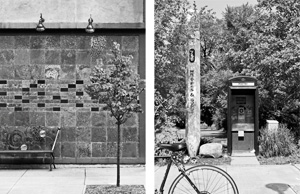 |
Art and an Oil Change #3 by Steve Malloy Desormeaux All of Steve’s dramatic and thought provoking prints, have two separated and diverse images, where the division between them is clear cut, except for numbers 1 and 8, where the separations are real, and an important element in each photograph. For the viewer of these striking and powerful images, I would hope that they do not try to envisage what the artist had in mind when he deliberately juxtaposed two different scenes, but instead, carefully study the prints and try and see what they really convey to them. I was especially drawn to #3, for, despite the many similarities and differences between the two images, there is a fascinating and compelling unison when one studies them side by side. There is a distinctive commonality of vertical and horizontal lines which relate to stability and formality, and this is offset by the strong abstract connection between the modern, artistically designed half-bench, and the more conventional half of a stationary bicycle. There is a charming relationship with the multi-treed presence in the right-hand print, reprised by the lone single-tree standard in the left-hand print, both offering a defining statement in support of the neighborhood. Although both prints are creatively vertical, the curved designs of the bench and the two spotlights, integrate harmoniously with the bicycle wheel and the curved features inside the telephone booth. For myself, the dramatic interplay between the two images is not just a question of the old versus the new evolving side by side, it is more about harmony and the rapport that each picture has with each other. At any time I can actively engage in the right-hand print, explore the phone booth, visit the “Writers and Books” venue, and then, when I feel like a rest, I can bicycle in my mind across to the left print to both admire the artistry and relax on the bench and commune with nature through the solitary tree. In summary, Steve has aesthetically given us two wonderful prints in which I can actively partake in both images, so that when I have tired of the excitement and challenges in one of them, I can travel to the other for rest and contemplation.
Peter A. Marr | 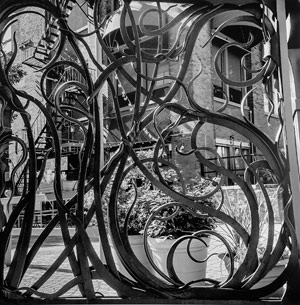 | NOTA #3 by Gil Maker Of all of Gil’s excellent and enlightened B/W prints, NOTA #3 had a profound effect on me, especially as it beautifully illustrates the diversity that is so commonplace in the NOTA neighborhood, particularly with reference to the old versus the new. In the background, one sees a very large building, a less than inspiring vertical scape of brick and steel, home over countless years to a variety of tenants and businesses. Currently, it appears that the lower floor is home to a Mall entrance and to a restaurant, the presence of both of them being advertised by a string of unsightly lights. Residents of the upper floors have the necessary pleasure of having an enormous fire escape that dominates the left hand side of the building. In the foreground of this unspectacular setting is an open brick-like tiled courtyard, with at least a semblance of some design qualities in the curved portion at the bottom left. The last viewable, hideous detail, is the mandatory array of potted plants, somehow surviving in nondescript pots. Having set the tone for an unremarkable area, Gil’s print makes a stunning transition, attributed to the fact that the whole scene is photographed and captured through the framework of the most elegant and artistic gate that one could imagine, namely, an Albert Paley masterpiece. The internationally renowned metal worker has created a sculptured edifice of flowing carved steel designs, with twists and elegant formations that are so beautiful as they are magnificent. For myself, I cannot help wondering if this massive awe-inspiring gate is an entrance to an area that we cannot see, or a barrier so that one cannot trespass or want to go to the building area that one sees beyond. In conclusion, Gil has creatively seen and photographed this NOTA area, resulting in a visionary print that I am sure he is very proud of, and everyone should congratulate him for such an insightful image. Peter A. Marr |  | 740 University Ave by Don Menges In a series of outstanding color prints, Don has given the viewer a remarkable opportunity to explore the incredible diversity of buildings that front University Ave, where the prolific variety of both architecture and design features, directly relates to striking changes in the neighborhood over the last fifty years or so. In all of these prints, I wanted to visualize what some of these changes were, so what better than to choose “740 University Ave,” a building that definitely has had a major change in occupancy. Firstly, I admire the way that Don as captured this beautiful building in a horizontal rather than a vertical format, so that one can focus intently on the imposing central entranceway. All of us can immerse ourselves in this print, and picture what could have transpired when #740 was the home of the 3rd Precinct Police Station. The latter name is boldly and proudly emblazoned above the main doorway, an entrance which also displays distinctive architectural components, including an eagle edifice over the door. It is not too difficult to visualize that there was a considerable time when this station was a hive of activity, 24 hours a day, and seven days a week, particularly through the prohibition and depression eras. One should then pause and question when and why this station was closed down, perhaps it may have been the centralization of the police force, or the expense of modernizing this building. What has definitely happened is that it is the end of a fabled era, and the birth of another one, where the dramatic change of occupancy is from a dwelling of extensive physical activity and high noise level into the peace and calm of the “Writers and Books Literary Center.” The current owners are very fortunate to occupy such a delightful and historic building, and we are deeply indebted to Don for this lovely print, which truly illustrates the old and the new changes in the NOTA neighborhood. Peter A. Marr | 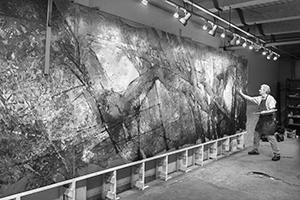 | Steve Carpenter by John Solberg John’s impressive series of prints of artists at work in their studios, is a great tribute to the countless hours that he spent with each artist, resulting in images that have a magic and intimacy that is unsurpassed. The prints are creatively presented in B/W, a media that is so uplifting for the subject matter. My favorite image, Steve Carpenter, has movement and a dynamism that is just exhilarating, depicting an artist really at one with the painting, exuding a passion and excitement that is just remarkable. One might argue that this enthusiasm is because the piece is almost complete, but I certainly beg to differ. One is immediately struck by the vast scale of the project, for the very large canvas virtually dwarfs the artist, and I imagine that keeping everything in perspective must be a great challenge. The more that one studies this striking mural, other salient questions come to mind. For example, was this a commissioned project?, and if so, what freedom did Steve have in the design and content in order to fulfill the client’s wishes? Without personally viewing the piece, my inclination is that one is witnessing a forest scene in which a riderless horse is charging through a glade of trees, but of course this is pure speculation. John has created a strong visual statement by including a large area of the concrete floor. The starkness and coldness of this large area to me, represents a bleak, empty canvas, which in time, has been brilliantly transformed into the masterpiece that Steve is in the process of completing. I hope that eventually many of us will be able to view this exciting work of art, but at this time, our reward is to study John’s powerful print, an example of creative photography at its very best. Peter A. Marr | 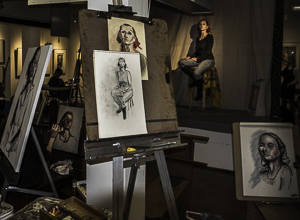 | Steve Carpenter's Studio by George Wallace George, as always, has on display a series of inspiring and poignant prints of the NOTA neighborhood, that encompasses environmental and social portraits, both inside and outside various venues in this very diverse area. What I truly admire about this “Studio” setting, is the incredible feeling of quietness, coupled with the sensation of intense activity, an area where originality and artistic skills are honed to perfection. George has certainly used his artistic seeing skills to create a strong visual statement. What I respect and appreciate in this studio, is that at this time, there is very little influence from the outside world, allowing each artist to experiment and explore, and expand on their artistic talents in any direction that they would like to go. The author has superbly captured the intensity and atmosphere by the way he has handled the subdued lighting, in a way that highlights every important feature for maximum effectiveness. The print masterfully captures the model seated on a simple wooden high chair, yet carefully allows the viewer to enter and admire the various portraits imposingly displayed on easels in the foreground, and on walls in the background. George, to his visionary credit, has cleverly captured the whole essence of a very active art studio, whilst carefully not highlighting any of the artists themselves, only showing examples of their work to show their diversity of artistic talents. Left to the imagination is the presence of the resident artist and Studio owner, namely, Steve Carpenter. I am certain that his critiques and encouragement for each artist is very much an important part of this setting. What I really admire in this print is that George has creatively captured a magical moment, and given us a stellar image for everyone to enjoy and comment on if they so desire. Peter A. Marr
| 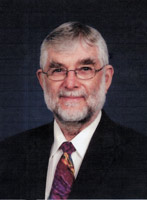 | We are very grateful to Peter for his thorough review and selection for Peter's Picks. Peter was born in England in 1935 and came to live in the United States in 1968. He worked for the Eastman Kodak Company for 34 years, retiring in 1998. During his employment and continuing into retirement, he has been an enthusiastic photographer. His photography has won him numerous awards throughout Kodak and in International Salons, including 5 George Eastman Medals, which is the top honor awarded to the most outstanding picture in the Annual Kodak International Salon. He has served as a judge in both local and international photographic competitions for the past 20 years, and is a Past president of the Kodak Camera Club and past chairman of many of the Kodak Camera Club organizations. In the past five years or so, he has devoted his photographic skills and interest into nature photography, notably bird photography. His bird photography has been the subject of several one-person exhibits, the most recent being at Ding Darling NWR, in Sanibel, Florida, The Roger Tory Peterson Institute in Jamestown, New York, and at the Webster Public Library in Webster, NY. |
Gallery Picks of the Exhibit
| 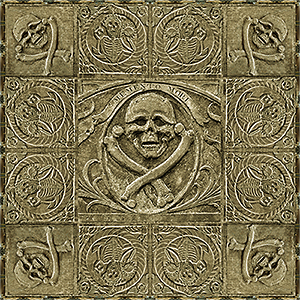 | Skeleton Mandala
by Jane Hopkins The Skeleton Mandala is a mosaic of images assembled with striking symmetry and balance from photographs taken in Massachusetts and South Carolina. The theme MEMENTO MORI (“Remember that you will die”) is the banner above the central skull, and the skull is echoed in the four corners. The two skeleton-snake carvings along each side are reflections of each other and complete the mandala circularity. Not only do the mosaic images work effectively together, but the mandala has been constructed with such skill that it could be mistaken for a single carving. The colors, tone, and shading, the edge along the outside, the seamless joining of the many elements tie them together into a single whole.
| 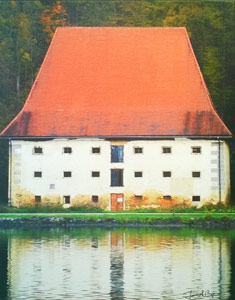 |
Reflection on the Danube
by Lou Ryen
Lou Ryen is an accomplished photographer who has traveled the world and shown his work in many locations in Rochester and around the world. He is exhibiting nine vivid images from Germany, France and the local area. His Reflection on the Danube stands out in this presentation. The Danube is Europe’s second longest river and passes through or touches ten countries and four capital cities on its way from the Black Forest in Germany to its delta in the Black Sea area of Ukraine and Romania. Once a long-standing frontier of the Roman Empire, the Danube has been the scene of important battles, travel by ocean vessels, a major link for economic transport and dazzling vistas of major cities along its route. Yet, Lou has decided to capture the Danube with a single building and its reflection on the serene Danube River. The simple structure of a rectangular building and a trapezoidal roof bespeak a rural life style of dedicated and hard working artisans and farmers. The red of the roof is striking yet it is the reflection, which Lou directs us to view. He selectively suggests that the rectangular lower portion of the house is the focus of his photography. Rather than a shimmering reflection in the water, the treatment of this image on canvas further emphasizes the rusted and faded whites and colors of the main part of the house. The lack of context within the photo leads the viewer to wonder where this building is located and what it is used for. The simple three-story structure has none of the accoutrements of a house such as a garden or curtains in the windows. Neither does it appear, at first glance, to be a factory. Perhaps an inn or rooming house Lou’s choice of this particular building reminds us that even in the most robust and populated areas of the world there also exists mystery, simplicity, serenity and symmetry to life. |  | Houston (Geometric)
by Hiatt Zhao Hiatt has combined some very interesting techniques to create a structured abstract image. Using wonderful geometric patterns consisting of triangles, squares, rectangles, and more triangles, Hiatt has taken photographic license to position himself in such a way that the angle of this image is impossible, yet the structure remains solid. The sky and its reflection are the final components that bring reality to this abstract. This image confuses the viewer at first, while the recognizable elements urge you to continue studying the image to find the connection. The angles are sharp and determined, then the sky and clouds soften the impact and you begin to focus and finally recognize the subject. Well seen. Well composed! |
|









